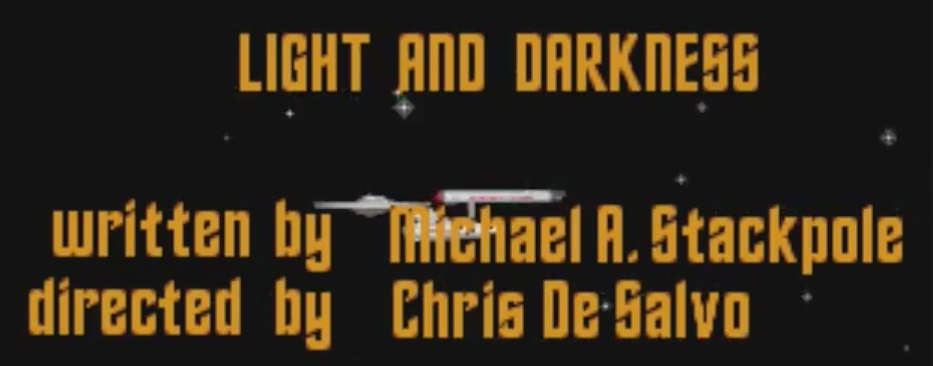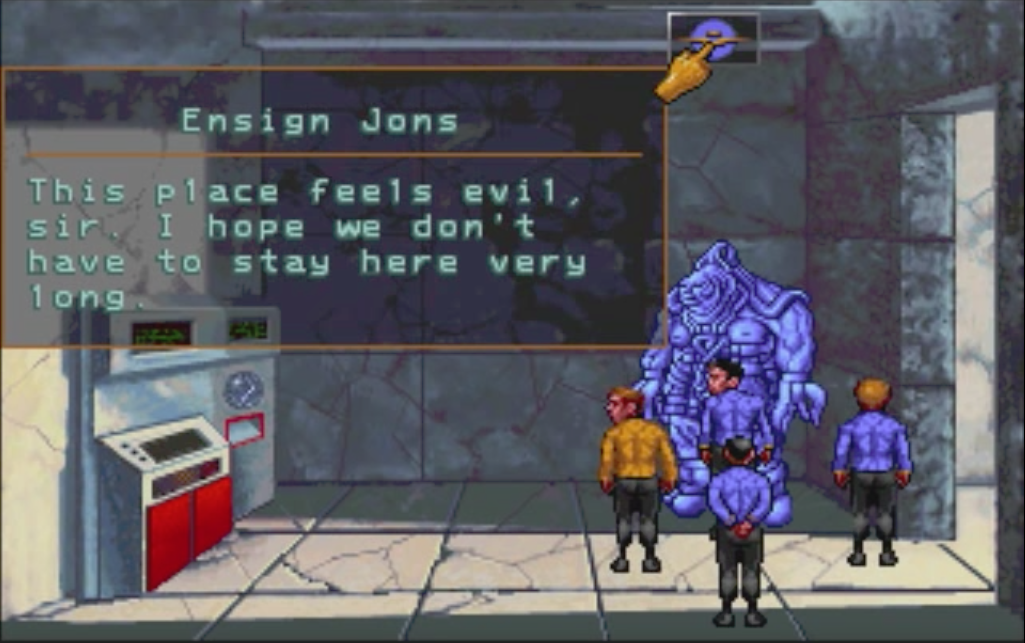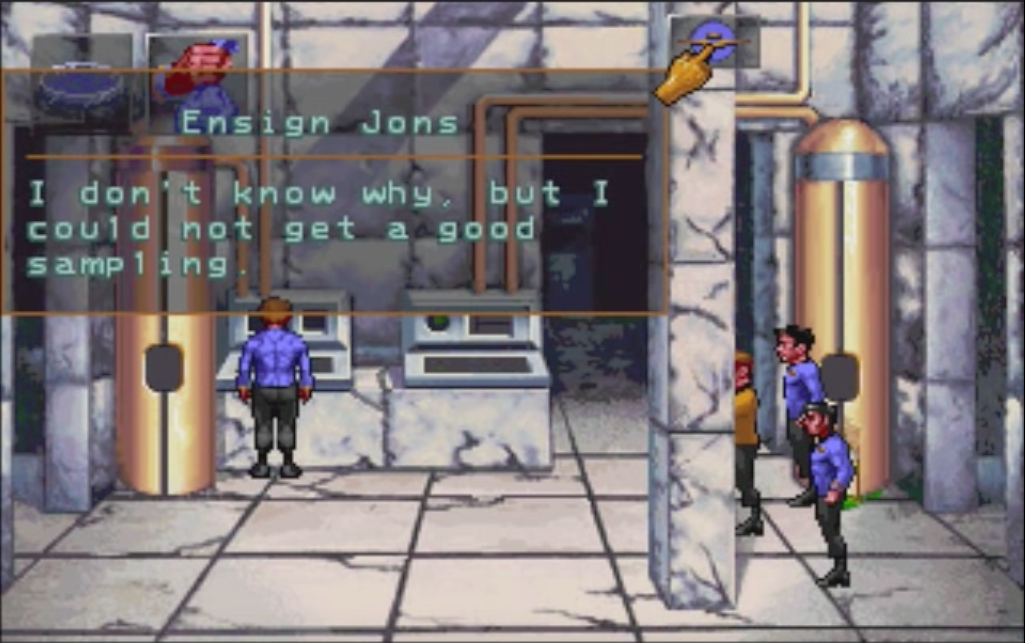
“Light and Darkness” is the second part of the game’s major story arc, and it cuts right to the chase: there’s some kind of distress signal coming from Onyius II, go check it out. The economy of storytelling is impressive. No drawn-out space battles, no jibber-jabber—simply straight to the action.
Only two life signs emanate from the entire planet. When you beam down, you appear directly in front of a building that’s in astoundingly good shape considering it’s on a planet that constantly gets pelted by micrometeorites. That’s not the only object looking hale and hearty around here: exploration of the premises reveals a recently deployed array of highly advanced satellite dishes, and the inside of the building is equipped with genetic replication equipment that the science team all agrees is state-of-the-art despite the tricorders pegging it as 50,000 years old.
For this mission, you’re accompanied not by a redshirt, but rather a blueshirt: Mr. Jons, a genetic specialist. Like Mr. Ellis in the previous episode, Ensign Jons is rather outspoken, although not in the same fashion. His scientific comportment belies his penchant for off-the-cuff anecdotal assessment and off-putting unprofessionalism. He describes the planet surface as “creepy” and at one point notes that “the difference between this place and hell is flames”, and when you enter the building, he claims to sense something evil, “something that wants to imperil [their] souls”. In case it’s not obvious from these cherry-picked quotes, Ensign Jons is devoutly religious, a fact you will remember every time he goes off on a high-pitched nasal jag about the preciousness of life or the importance of defeating evil, which is approximately 2 to 8,000,000,000 times per screen.

Ugh shut UP
Inside, there are two rooms to the left and right of the entryway, each of which houses a machine that contains a colony of single-celled organisms and projects an image of a mythological being when activated. The organisms behind the glass have diametrically opposite compositions: one has a amazing metabolism but a poor reproductive rate, while the other breeds like rabbits but has virtually no metabolism. Only by convincing the mythical projections that the two organisms need to unite into one to combine their strongest traits can you ensure their continued survival.
Jons, unsurprisingly, provides the major moral dilemma for the mission. When asked to sequence the DNA of the two single-celled organisms, he does the Omegan sample just fine, but then clumsily pretends that something goes wrong while sequencing the Alphan sample. To move forward, you have to bring him around to the realization that you’re dealing with single-celled organisms with no capacity for morality without antagonizing or ridiculing him. The proper dialogue choices are somewhat telegraphed, but he’s such a whiner that it can be pretty darn tempting to serve him a little extra salt.

Pictured, right to left: Mr. Spock, Dr. McCoy, Captain Kirk, Ensign Liar-Liar McLiarpants
Interplay had explored this sort of territory previously. Star Trek: 25th Anniversary‘s first mission, “Demon World”, featured the Acolytes of the Stars. In that mission, you checked in on the status of a mountain that the Acolytes claimed was summoning demons to scare off people who approached it. Although religious, the Acolytes also greatly valued scientific discovery, but opted to stay over on the sidelines while you conducted your investigation. Juxtaposing a fear of demons with high standards of scientific rigor was a little weird, but never presented an obstacle. Here, it’s a Starfleet officer who’s bugging out about demons, and he puts his own agenda above the success of the mission, so it’s not only more than a little annoying, it’s dangerous and insubordinate as well. Overall, it’s a bit of a retread, but that can be forgiven, since the writer for “Light and Darkness” is something of a celebrity ringer (more on that below).
In the end, the testers come forward, identifying themselves by name for the first time: the Brassica. Essentially, you’re being tested on your ability to deal with cognitive dissonance: the “demon” is unusually calm and advocates for peace, logic, and reaching across the aisle, while the “angel” has zero chill and is bloodthirsty and self-absorbed. You’re also given a status update: roughly one in five test subjects make it as far as you have, with the not-so-fortunate ones either dying or failing for other unspecified reasons. But that’s not you: you’ve made it into the highest echelon of Brassican test subjects, and the way is clear for you to move forward into the final battery of tests.
“Light and Darkness” was written by Michael Stackpole, a celebrated author of tie-in literature, though Star Trek is not his usual milieu. As an author, he’s much better known for his work in the Star Wars and BattleTech universes. Where religious affiliation is concerned, he appears to be a skeptic, which explains his choice of subject matter and his approach to it. Although solidly written, neither of the Brassica-arc missions are paragons of excitement exactly, but having a setup as dry as the surface of Onyius II is acceptable when it results in the payoff we’re going to get in the game’s final two episodes.
MVP & LVP
- I give my MVP for this mission to Dr. McCoy. Ensign Jons could learn a thing or two from Bones about how to keep things breezy. The good doctor can always find exactly the right moment to add a bit of levity, but he also knows when it’s time to get serious. He even gets a lot more positive feedback from Spock than usual in this one.
- Do I really have to say it? Ensign Jons, man. What a poindexter.
Nuggets & Other Stray Bits
- Before entering standard orbit around Onyius II, Spock lampshades the series’ defining phrase, in the process outing himself as a dirty rotten prescriptivist:
“A split infinitive, Captain.”
“What?”
“The proper grammatical expression is ‘to go boldly, where no man has gone before.”
“Somehow I think it loses a little in the translation.”1 - I always appreciated the animation of the ship’s phasers blasting the rock.
- There’s a bit of a contradiction in the writing where Uhura emphasizes that communications might be difficult because of interference from the magnetosphere, yet this mission relies more on the communicator than any episode to this point and communications are never less than crystal-clear either time. To be fair, however, I’ve been playing this game for 25 years and this is the first time I noticed it, so it must not be that big a deal.
- “Light and Darkness” is one of the few episodes that requires you to perform actions in a certain order for the optimal score. Somewhat unintuitively, you must first explore the surrounding area and repair and readjust the satellite arrays before ever entering the building. That’s not to say beginning with a survey of the premises is illogical, but it only seems perfectly natural to want to enter a building that you’re dumped in front of to begin with.
- At the end of the mission:
McCoy: “You can never trust anybody, and people who look like pointy-eared hobgoblins are definitely at the bottom of the list.”
Spock: “It appears that Dr. McCoy did not learn the lesson of this mission either. Unfortunate, but not unexpected.”
NEXT TIME: Forcing a grin for the game’s toughest mission, “Voids”


M00NSIDIAN
So, because I love trivia and because the name of the Brassica has been revealed at this point, I feel like now it’s acceptable to point this out:
The Brassica ACTUALLY REAPPEAR in one of the Star Trek: Vanguard novels — “Reap the Whirlwind,” written by David Mack. The novel has a pretty major continuity error, but apparently Mack didn’t know that the Brassica had shown up somewhere else before then. (They’re also called the “Brassicans” but are described pretty similarly, so that’s probably just another mistake. Poor guys, being subjected to this many mistakes. I kinda like the Brassica. Brassicans. Either one…)
I know one other interesting thing about the Brassica, but I’ll keep that under my hat for a while because I think it might count as a bit of a spoiler. Minor, I guess, but still!